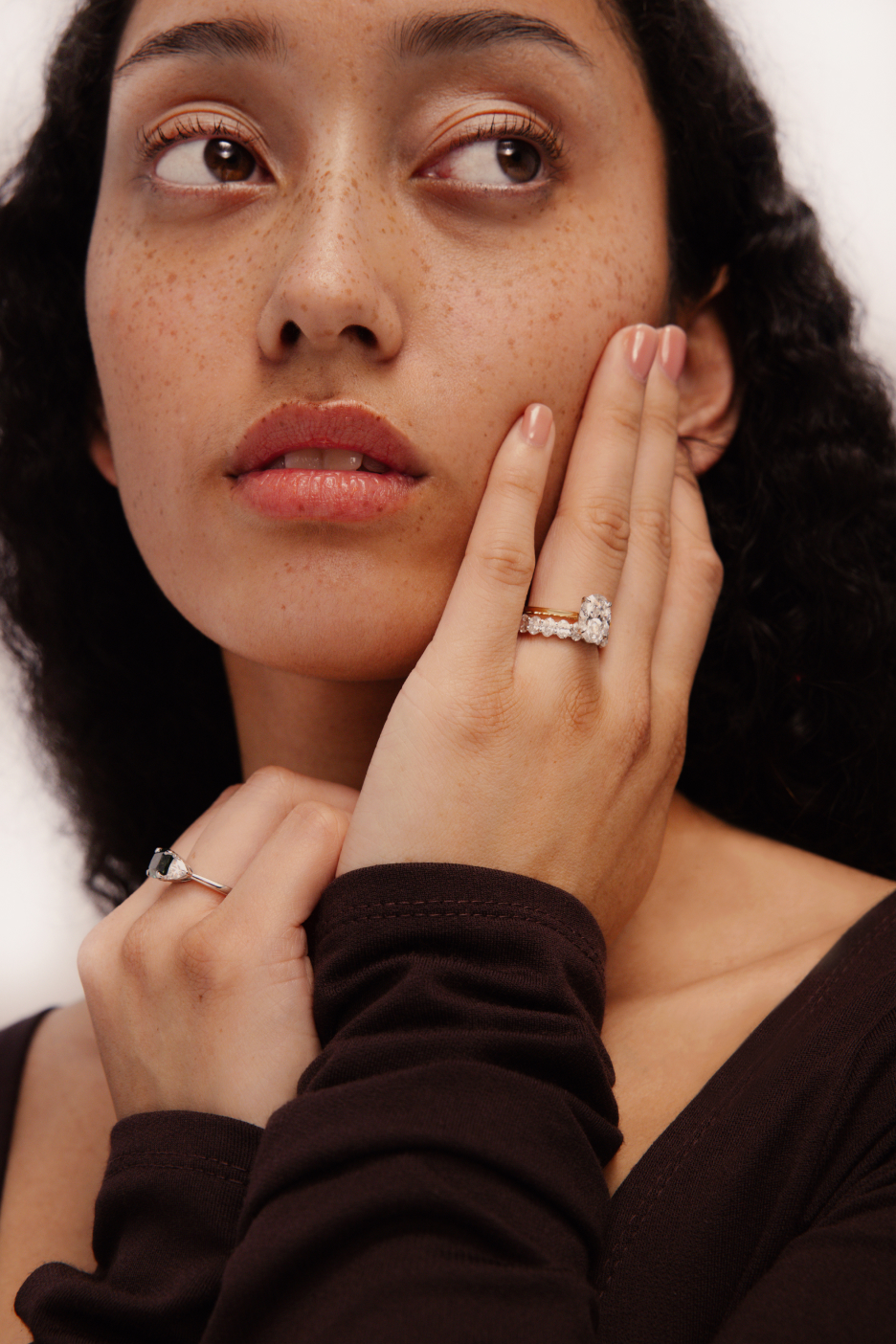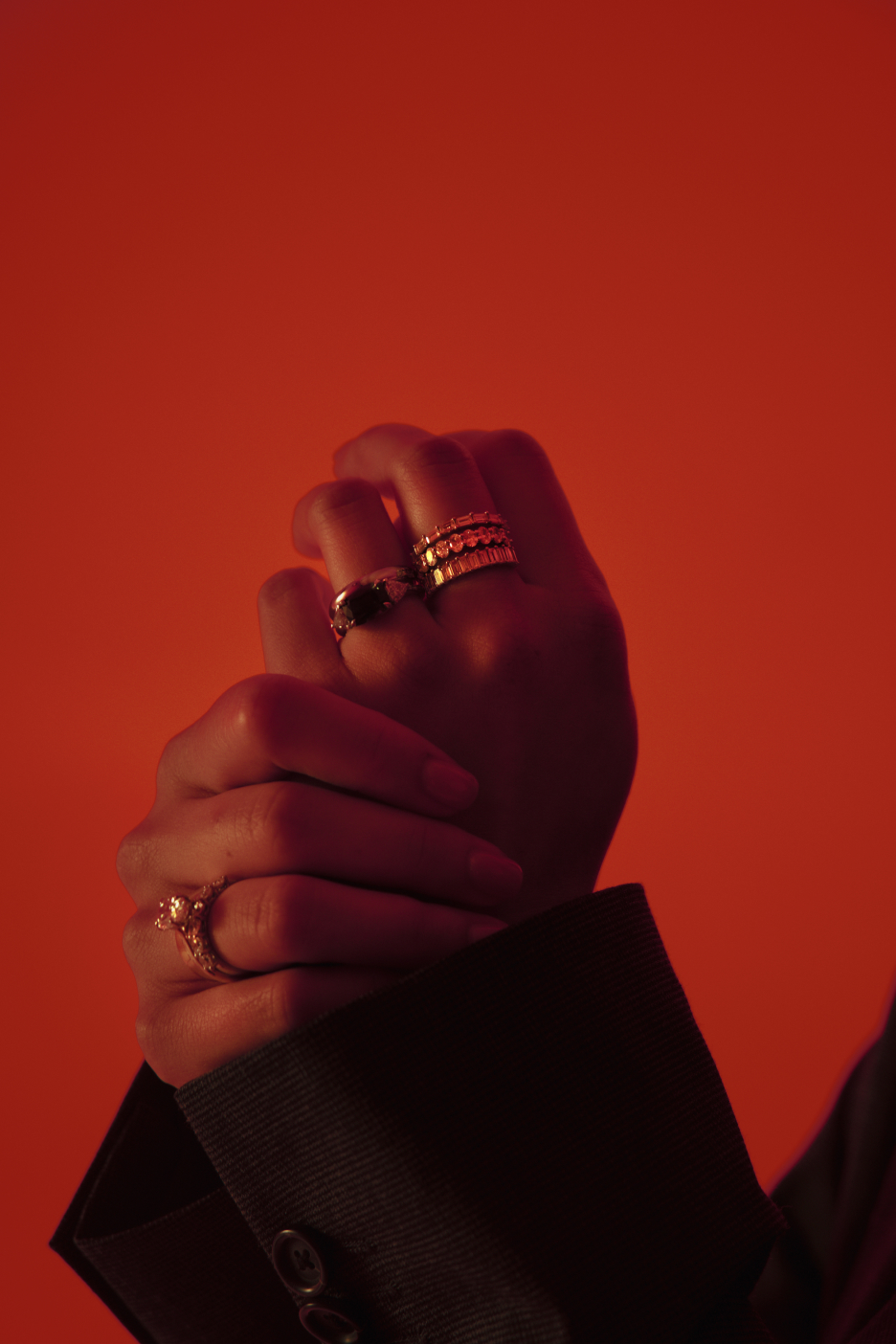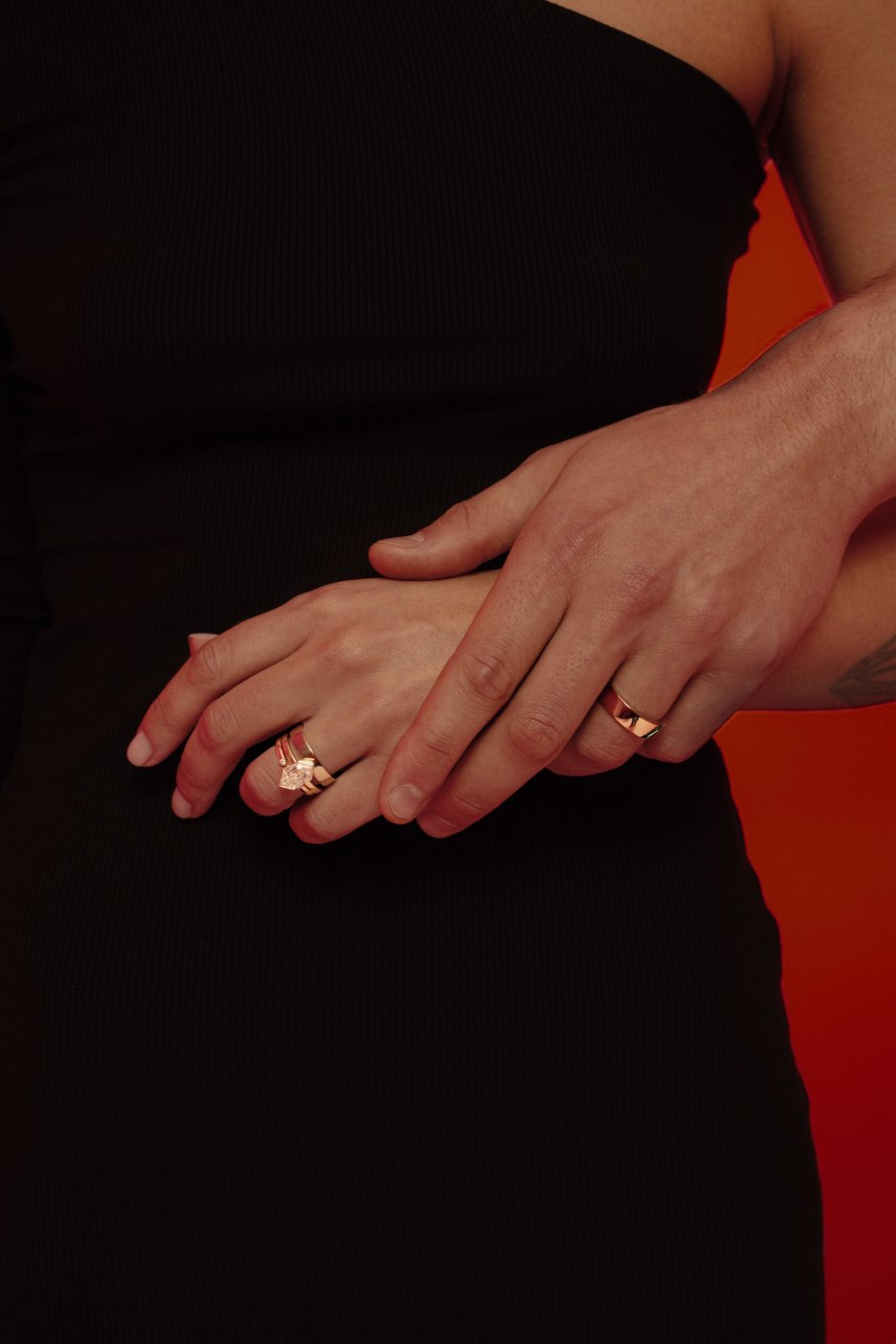Why are diamonds expensive?

When you are looking to propose to your partner, there is an expectation that you need to spend a lot of money to ensure that they will say yes.
In reality, the price of the ring is not the biggest determinant of if they will say yes. It is the love between you.
If you are going to surprise your partner with a proposal, it can often be difficult to know how much to spend on an engagement ring, let alone understand what they will like. After all, they are going to wear it for the rest of their life. To make things more difficult, going into a jewellery store can be intimidating, especially when the salespeople hear the word engagement ring.
So how can you ensure you get something within your budget and something that they like? Read on to learn about the differences in diamond ring prices and why mined diamonds are so much more expensive than lab grown diamonds.
How did De Beers control the diamond supply?
Compared to other gemstones, diamonds are much more expensive. But the funny thing is that diamonds are actually one of the more common gemstones on the planet (but not all diamonds are jewellery quality). Gemstones such as rubies and sapphires are actually a lot rarer than diamonds. In fact, diamond engagement rings were actually quite rare in themselves before the 20th century. Before then, ruby and sapphire rings were the most popular gems for engagement rings.
So how did diamond rings suddenly become engagement ring gemstones? And why are they expensive? It all starts with learning a little bit about the history of the diamond trade.
Up until the late 19th century, diamonds were legitimately rare because they were hard to find. Before 1870, diamonds were only found in a few places in the world — in riverbeds in India and in the jungles of Brazil. The total amount of diamonds before 1870 was only a few kilograms a year. Investors liked the idea of diamonds because they were legitimately rare at the time and they did hold value.
But in 1870, huge diamond mines were found in South Africa. Diamonds were being scooped out by the tonne and the market was flooded with diamonds. The diamond expedition was *too* successful to the point it would crash the price of diamonds. And to make matters worse, diamonds have no intrinsic value. The price of diamonds was purely based on scarcity.
The financiers of the expedition quickly realised that if they could control enough of the diamonds, they could limit supply and create an illusion of scarcity. The major financiers of the diamond mines had no choice but to pull together to make sure that this idea would work. In 1888, they created an entity called De Beers Consolidated Mines, Ltd.
Over the next century, De Beers would go on to control not just the mining of diamonds across most of the world, but also its trade and sale to resellers so that they could control the supply and price. They set up innocuous names across the world. For example, in London, De Beers set up a company called the Diamond Trading Company. In Europe, they set up the ‘Central Selling Organization”.
For the most part of the 20th century, De Beers owned or controlled all the diamond mines in southern Africa (not just South Africa) and owned diamond trading companies in a lot of Europe (i.e., England, Portugal, Belgium, Netherlands and Switzerland).
This cartel has been one of the most successful in history. While other precious metals and gemstones have fluctuated in response to the strength of the economy, mined diamonds have mostly continued their increase in price (up until recently). The cartel was so successful in its endeavour to restrict the supply of diamonds onto the market, that some investors in the 1970s saw it as a hedge against the U.S. dollar’s inflation.
However the success of the cartel was not in just controlling the supply. De Beers also needed to ensure that they could manufacture enough demand to justify the price. To do this, De Beers had to ensure that diamonds represented tokens of wealth, power and romance — especially in the changing face of social norms and technology. Not only that, but De Beers also had to ensure that a secondary market for diamonds did not develop as it would then face the same fate as precious metals and other precious stones. It needed to ensure that people would not try and resell the diamonds and that diamonds were something that people needed to hold on to forever.
And that is exactly what De Beers did. In 1938, the price of diamonds began to collapse. This was due to the ongoing global depression and the possibility of war. Furthermore, in key countries such as Germany, Italy and Spain, the idea of giving a diamond ring during a proposal hadn’t taken hold. Diamonds also had a perception problem. They were seen as the jewel of aristocrats and not for the masses. This left the United States as one of the only financially feasible places to sell diamonds. And even then, three-quarters of all diamonds beings sold were in the United States. Most stones at the time were smaller and of poorer quality compared to those that were being sold in Europe. Furthermore, the diamonds that were being sold in the United States were selling at around $80 USD.
How did diamonds become popular?
Oppenheimer, a son of one of the founding fathers of the De Beers cartel met with Lauck, the founder of a marketing agency called Ayer. Ayer conducted market research and found that the price of diamonds and interest in them had been falling ever since the First World War. It also found that because of the economy and changes in social attitudes, diamonds were no longer seen as luxurious items (in the United States).
Nonetheless, Lauck, with his agency Ayer took on the project of helping De Beers reposition diamonds in the US markets. Lauck believed that if diamonds could be paired with the association with romance, it could improve the sale and value of diamonds. Ayer did this by using movies and Hollywood stars to change the perception of diamonds. Stories would stress the size of diamonds and photographs would show the glitter of the diamonds on a woman’s hand.
In three years, Ayer had achieved amazing results for De Beers. The sale of diamonds had increased by 55% in the United States since 1938, which reversed the previous downward trend in retail sales. And it came off a nuanced understanding of how and why people buy diamond engagement rings. It was that for more prosperous couples, there is an urge to be different, or at the forefront of style. For less prosperous couples, it was to show that they were wealthier than they appeared - an expression of socio-economic achievement.
And in 1948, Ayer ran one of the most successful marketing campaigns of all time — one that is still running. A copywriter from Ayer named Frances Gerety came up with the slogan “A diamond is forever.” It was a fitting slogan because it reminded people that it must stay forever in the family and for it never to be sold. This would ensure that no secondary market for diamonds would develop. It also ensured that diamonds would remain as the ultimate symbol of love when it came to engagements — all during a time when the allure of diamonds began to fade. The campaign below is just one example of how De Beers used the slogan ‘Diamonds are forever’ to keep diamonds top of mind.
Here are two popular examples:
Towards the end of the 1950s, Ayer reported to De Beers that after 20 years of advertisements, it had a pronounced effect on the American psyche and their views on diamonds. And since 1938, a whole new generation of buyers has entered the market believing that a diamond ring is a necessity when proposing.
In the 1960s, De Beer’s focus shifted to other markets — most notably Japan, Germany and Brazil. They engaged with J. Walter Thompson; another advertising agency. Within ten years, De Beers succeeded beyond its expectations creating a billion-dollar-a-year market in Japan. It did this by creating a sharp contrast between the traditional and oriental past, and an entry into the modern and Western way of life. In 1967, only 5% of women had a diamond engagement ring. And by 1981, a whopping 60% of Japanese brides wore a diamond engagement ring.
How did diamonds become internationally known as the gemstone for engagement?
In the last 30 years, this marketing effort has been rinsed and repeated in other countries such as China and India. And for the next ten years, the demand for diamonds will mostly be coming from developing countries - in both carat size and in the volume of diamonds (due to their population sizes).
But in the last 30 years, De Beers also no longer has a complete monopoly on diamond supply. In fact, since the 1970s, De Beers has been threatened by its members, governments, banks and newly found mines to destabilise the diamond supply.
Changing tides on the mined diamond supply chain
Too many diamonds in the market would lead to a price drop. And not enough diamonds in the market would also lead to consumers losing interest in diamonds as a representation of love.
In as early as 1978, De Beers feared losing its monopoly on the supply of diamonds. Diamond dealers in New York found that factories in Israel were stockpiling diamonds rather than passing them down the supply chain to reach New York. This was motivated by seeing diamonds as a hedge against Israeli currency inflation. Since the early 1970s, the price of diamonds has been increasing rapidly, and the Israeli currency has been devalued. It made more sense for the factories to hold onto the diamonds than to sell them.
A shortage started to develop in New York which pushed the price of diamonds up quite substantially. De Beers estimated that the Israeli stockpile was as large as 6 million carats and growing at a rate of around 500,000 carats a month. At such an enormous quantity, the De Beers cartel could no longer fix the supply and price of diamonds. At any time, the Israeli diamond cutters could pour the diamonds onto the market. The cartel decided that it had no alternative but to force the liquidation of the Israeli stockpile.
De Beers did this by clamping down on the banks that were financing the diamond purchases with artificially low interest rates. They imposed surcharges on diamond purchases as high as 40%. Furthermore, Israeli banks couldn’t afford to advance 80% of a purchase price that included the surcharge. De Beers pressured the banks to raise their interest rates on outstanding loans. Within weeks, interest rates on loans to purchase diamonds went up by 50%. And instead of lending money on what Israeli dealers paid for diamonds, the banks began basing their loans on the official De Beers price for diamonds. But De Beers didn’t stop there.
De Beers cut off shipments of diamonds to forty of its clients who had been selling large portions of their orders to Israeli dealers. The Israeli dealers found it hard to buy or finance diamonds and were forced to sell diamonds from their stockpiles. This flooded the diamond wholesale market and the price started to fall dramatically. This then incentivised the Israeli banks to put further pressure on diamond cutters to sell their diamonds. It led to hundreds of bankruptcies as the prices continued to plunge. The bankruptcies led the Israeli banks to hold a large number of diamonds. They then listed it on the market which led to a price crash per carat of diamond.
The demise of the cartel
The most serious threat to De Beers’ cartel was not its supply chain issues as seen by the Israeli diamond cutters. It was the threat of another source of diamonds that it did not control. It faced this threat more than a few times. In the mid-1970s, it had to buy diamonds from Russia and newly independent countries in Africa in order to preserve its cartel.
De Beers had to manage a secret agreement that effectively meant that it brought the Soviet Union into the cartel. In the late 1970s, a large mine was discovered in Australia. Testing indicated that it could create a supply glut to the tune of 50 million carats a year — more than the entire production of the De Beers cartel in 1981. Although only a small percentage of these diamonds were gem quality, the total number produced would still be enough to change the supply of diamonds.
De Beers moved quickly to try and get a stronghold of the Australian diamond by creating a secret agreement. This would have been a relatively straightforward deal if it hadn’t been for Northern Mining Corporation — a minority partner in the initial diamond exploration. Instead of agreeing to the deal, Northern Mining Corporation leaked the terms of the deal to a leading Australian newspaper which reported that De Beers planned to pay the Australian consortium 8-% less than the existing market price for the diamonds. This resulted in a backlash in Australia with public opinion of De Beers left to crumble. A similar set of events happened in Canada. Both Australia and Canada decided not to go with De Beers which led to a more competitive market for rough diamonds. De Beers no longer had a monopoly. In the 1980s, De Beers held a 90% monopoly on rough diamond supply. By 2019, it only had a 29.5% market share of rough diamonds.
In its prime, De Beers made a profit by squeezing its supply chain and controlling the market price. This led to human rights abuses by suppliers and diamonds funding anti-government conflicts. This was exposed by Global Witness (an international NGO) in 1999. It found that diamonds played a big role in international conflicts and in 2000, De Beers Group stopped all outside buying of diamonds in order to supposedly guarantee the conflict-free status of their diamonds. To De Beers’ credit, it has made a concerted effort to ensure that its diamonds are not blood diamonds but this is more difficult than it seems. And just because a diamond is not a blood diamond, doesn’t mean that human rights and the environment have not been abused. You can read more about the ethics of diamond mining here.
Mined diamonds and the changing public opinion
After the famous movie Blood Diamond was released in 2006, social attitudes toward mined diamonds began to change. Consumers began to pay more attention to where and how their diamonds were mined. With the UN and social pressure, the Kimberley Process was established. This was intended to make suppliers more accountable and transparent in their mining processes and ensure that their diamonds did not fund any war against a government. You can read more here.
Interestingly, around the same time, there was a growing interest in lab grown diamonds which are physically, optically and atomically exactly the same as mined diamonds. This posed an existential threat to De Beers and the price of diamonds as manufacturers could now create diamonds in a lab and avoid the ethical and environmental moral hazards that mined diamonds carry.
How are diamonds priced now?
Nowadays, De Beers has a relatively small share of the diamond supply. And there has also been an influx of lab diamonds that has put downward pressure on the price of diamonds. But this doesn’t mean that the diamond price is going to completely crash. As with both mined and lab diamonds, the price of a diamond is determined by quite a few factors.
Supply chain
The supply chain of a diamond is incredibly complex. Mined or lab, it first needs to be acquired, cut and then sent for grading. This is typically done by an independent agency such as the International Gemological Institute (IGI) which is in Belgium, or the Gemological Institute of America (GIA).
Typically, the diamonds are not found in the United States or in Belgium so they need to be flown over for grading; and then sold to a diamond wholesaler. The diamond wholesaler then can either sell the diamonds directly to a merchant or turn the diamonds into rings. This typically involves shipping around the world with insurance on high-value goods. Either way, the diamonds are then placed in a ring. The ring is typically made out of gold, platinum or a mixture of the two. This is also a precious metal. This is typically made through some form of casting and then setting. The setting is also usually done by hand. Once a ring is complete, it is then ready for retail. Typically jewellery shops then sell an engagement ring to a customer. The jewellery shop needs to be fitted out, be staffed and also be secured. It is also best practice for the jewellery store to provide you with an insurance quote or cost of replacement. This also costs money. Some businesses also then carbon offset like Four Words, and not all have a physical retail presence.
Each person in the chain needs to get paid for the work that they have done. Each level involved also needs to ensure that they can market their business to be successful. The final price is the price you pay for all of these things to ensure that the diamond engagement ring that you buy is perfect.
The cost to make or mine a diamond
To create or mine a diamond is not easy. With mining diamonds, it takes a lot of exploration and heavy machinery to extract even just a few carats of diamond. The diamond mines also tend to be in very remote parts of the world. Furthermore, once a diamond mine is found, the diamond is not simply pulled out of the ground. It requires heavy machinery, a lot of people and obviously health and safety standards. It has been calculated that 250 tons of rock need to be moved to find **one** single diamond. And the diamond may not even be up to jewellery standards. This means an enormous cost — not just financially but also environmentally too. Additionally, after about 20 years, the mines are not profitable anymore.
The benefit of lab grown diamonds is that there is no need to go through exploration, the act of mining or even health and safety. Lab grown diamonds are grown in a lab. But the cost for the lab comes from the large amounts of electricity used. To learn more about the difference between mined and lab grown diamonds, click here.
Where to from here?
When buying an engagement ring, think about your values as a couple. Do you value ethics, the environment and ensuring that what you buy does not cause conflict?
If your answer is yes to these questions, it is important to ensure you know where your diamond is coming from and how it is made. It is also important for you to consider who gets squeezed out when you ask for the cheapest ring, especially in the mined diamond space.
For a frank discussion, reach out to Four Words to discuss your options on your engagement ring, and what we do to ensure that we are sustainable, ethical and conflict-free.






